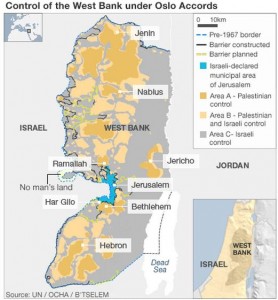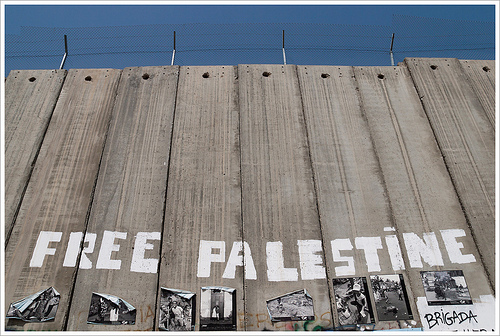As previously discussed, apartheid refers to a system of discriminatory polices which divide a population along racial lines and give superior treatment to one race over another. The objective of these inhumane laws is to maintain the domination of one race. The system of apartheid implemented by Israel in the Palestinian territories is designed to oppress Palestinian Arabs and give preferential treatment to Israeli Jews. We will now explore the different apartheid policies enforced by Israel (Note: Occupied Palestinian Territories (OPT) refers to East Jerusalem, West Bank and the Gaza Strip which have been under Israeli occupation since 1967)
Citizenship and immigration
Israel’s institutionalized system of discrimination is rooted on being able to classify population along racial lines. It first legally defines who is Jewish and then extends special privileges to Jews over non-Jews. Israel views itself as the state of the ‘Jewish nation,’ not an ‘Israeli nation.’ It thus distinguishes between citizenship and nationality [1].
Citizenship is granted to those qualifying its requirements; about 1.3 million Palestinians living in Israel proper have citizenship. Jewish nationals (i.e. anyone falling under the legal definition of a Jew) enjoy special privileges which aren’t accessible to ordinary Israeli citizens [2]. These special privileges will be discussed in this article. Israeli Jews are a group unified by law while Palestinian Arabs are sub-divided into citizens, occupied residents and refugees based on their territory [3].
The 1950 Law of Return extends to Jews all over the world an absolute ‘right of return.’ Jews from anywhere with no prior ties to Israel can immigrate to it and the Occupied Palestinian Territories (OPT) [4]. This law is rooted in the idea that Jews were expelled from this land 2000 years ago and should now be able to return home — the cornerstone of the Zionist movement.
On the other hand, the hundreds of thousands of Palestinian refugees who were either expelled or fled during the 1948 and 1967 wars are not allowed to return to their homes. They are granted entry in neither Israel nor the OPT simply because they aren’t Jews.[5,a] This restriction has created the one of the largest refugee crises in the history; today these refugees and their descendants number around 5 million. It is also in clear violation of UN resolutions, international law and the Geneva Conventions which state that everyone has the right to leave and return to one’s country [6].
While Jews are automatically granted Israeli citizenship, Palestinians are not afforded the same privilege and face insurmountable obstacles [7]. Palestinians within Israel proper have to prove they resided in Israel between 1948 to 1952 (i.e. during the worst of fighting) to be eligible [8]. Palestinians in East Jerusalem have to prove their ‘center of life’ is Jerusalem in order to simply retain their so-called permanent residency status [9]. Palestinian refugees living in the OPT have no rights to citizenship while Jewish settlers in the same area do [10].
In addition, in an attempt to close doors to the ‘creeping right of return,’ Palestinians in OPT are restricted from reuniting with their spouses and families in Israel; Jewish settlers face no such restrictions [11][12].
Land ownership: Palestinian enclaves, Jewish colonies
As discussed in the previous post, land distribution based on race is one of the defining features of apartheid. This is most evident in the West Bank which has been fragmented into numerous ethnic cantons or Bantustans.

The Palestinian enclaves (Areas A and B) are currently split up into some 131 disconnected Bantustans; these are surrounded by a contiguous region (Area C) under complete Israeli control [13a]. Jewish colonies are currently made up of over 220 settlements; 121 official ones and the remainder being unofficial ‘outposts’ which are built without Israeli approval. Residence and entry in each ethnic enclave is determined by one’s racial identity; Jewish colonists in one area and Palestinians in the other [13]. Settlers have access to all the amenities of a developed nation while most Palestinians live under substandard conditions.
Though they are illegal by international consensus, these colonies have been constantly expanding on land confiscated from Palestinians for four decades now. At present, 43 per cent of the West Bank is taken up by these settlement blocks which are for exclusive Jewish use [14]. Housing, schools, hospitals and recreational facilities in the settlements are inaccessible to non-Jews. While a Jewish person from any part of the world can move to and lease land in these cantons, Palestinians are barred from the use of their very own land. Continued expansion of the colonist enterprise means little is left of ‘Palestine’; effectively rendering the two-state solution meaningless. In fact, the official map of Israel doesn’t even demarcate the Palestinian territories from its own boundaries; clearly indicating its de facto annexation of the territory.
Given Israel’s constant claim to democracy, some might falsely argue that the settlements are not Jewish-only; rather they are Israeli-only. One of Israel’s traditional methods to direct national resources exclusively to the state’s Jewish population, without being accused of discrimination, is delegating responsibilities to the non-governmental organizations such as the Jewish Agency (JA), World Zionist Organization (WZO) and the Jewish National Fund (JNF) [16]. The JA, WZO and other parastatal institutions are currently responsible for the planning and establishment of the settlement enterprise [17]. These institutions act as ‘authorized agents’ of the state and solely work to serve interests of the world Jewry; effectively barring even non-Jewish Israeli citizens from their services.
Creation of the monstrous Separation Wall has further annexed 10 per cent of the West Bank into Israel [15]. The Wall is justified as a ‘security fence’; however, Israel has conveniently planted it on the neighbour’s territory — 85 per cent of it runs through the West Bank. As a result, the International Court of Justice (ICJ) deemed the barrier illegal. Although it hasn’t segregated the population entirely, the Wall has further divided it – 85 per cent of the the Jewish settlers live on the western side of this Wall [15a].
In addition to all this, Israel also restricts land usage within its own legally recognized territory. The state controls 93 per cent of the land in Israel and a government agency, the Israel Land Administration (ILA), manages and allocates this land. This land is owned either directly by the state or by quasi-governmental bodies that the state has authorized to develop the land, such as the Development Authority (DA) and the Jewish National Fund (JNF). According to Israel’s Basic Law, state land cannot be sold. The ILA usually leases land to individuals or institutions for periods of 49 or 98 years. [15b]
The JNF owns 13 per cent of this land and has an explicit mandate to develop land for Jewish use only — thus by definition off-limits to Palestinian Arab citizens [15b,c]. The ILA’s Governing Council is comprised of 22 members–12 representing government ministries and 10 representing the JNF, thus giving the JNF a hugely influential role in Israeli land policies and allocation. The ILA lacks any mandate to disburse land in a fair and just fashion. While by law Arab citizens can lease land owned directly by the state and not transferred to the JNF, in practice numerous obstacles limit Arab citizens’ access to land. It is estimated that Arab citizens are blocked from leasing about 80 per cent of the land controlled by the state. [15b]
Dual legal systems
Israel has implemented two systems of law in the Palestinian territories. It applies Israeli civilian law to Jews while indigenous Palestinians are subject to military law. It treats the settlements as de facto extensions of Israel and grants settlers the rights of citizens with democratic protections, despite them living outside Israel on occupied Palestinian land [18] [19].
Being subject to the Israeli judicial system, Jewish settlers enjoy liberties and legal guarantees that are denied to Palestinian defendants in the Occupied Territories charged with the same offense. The authority to arrest an individual, detention period before hearing, the right to an attorney, the protection for defendants, the maximum punishment period, and the release of prisoners before completion of their sentence — all of these differ greatly in the two systems of law, with the Israeli civilian system providing the suspect and defendant with many more protections [20].
Thus, different legal systems are applied to two populations residing in the same area, and the nationality of the individual determines the system and court in which he or she is tried. This situation violates the principle of equality before the law, especially given the disparity between the two systems. It also violates the principle of territoriality, conventional in modern legal approaches, according to which a single system of law must apply to all persons living in the same territory [21].
Waleed Ahmed is a freelance writer based out of Toronto. He enjoys writing about current affairs, human rights and religion.
Photo: flickr/Libertinus
Check out the entire Talking About Israeli Apartheid Series.
References
[1] Occupation, Colonialism and Apartheid? Human Sciences Research Council,South Africa, 2009 – pg 161
[2] Ibid, pg 216
[3] Russell Tribunals on Palestine — Capetown Session, 2009 . pg 14
[4] Acquisition of Israeli Nationality — Israeli Ministry of Foreign Affairs
[5] United Nations Human Rights, Report of the Special Rapporteur, Richard Falk. ID A/65/331, August 2010 — pg 6
[5a] Occupation, Colonialism and Apartheid? Human Sciences Research Council,South Africa, 2009 – pg 213
[6] Palestinian Right of Return — Wikipedia
[7] Occupation, Colonialism and Apartheid? Human Sciences Research Council,South Africa, 2009 – pg 21
[8] Immigration and Refugee Board of Canada, Israel: Citizenship Law, 6 March 2008, ISR102749.E
[9] Occupation, Colonialism and Apartheid? Human Sciences Research Council,South Africa, 2009 – pg 206
[10] Ibid, pg 217
[11] Forbidden Families: Family Unification and Child Registration inEast Jerusalem. January 2004. B’Tsaleem, Jerusalem.
[12] Occupation, Colonialism and Apartheid? Human Sciences Research Council,South Africa, 2009 – pg 211
[13] Ibid. – pg 19
[13a] Forbidden Roads: Israel’s Discriminatory Road Regime in the West Bank, B’Tselem. August 2004- pg 4
[14] Separate and Unequal: Israel’s Discriminatory Treatment of Palestinians in the Occupied Palestinian Territories. Human Rights Watch, New York 2010 — pg 9
[15] The Humanitarian Impact on Palestinians of `Israeli Settlements and other infrastructure in the West Bank. UN Office for the Coordination of Humanitarian Affairs, 2007
[15a] Arrested Development: Long Term Impact of the Barrier, B’Tselem. -pg 13. October 2012
[15b] Off the Map, Human Rights Watch, March 2008
[15c] Israel and the Occupied Territories — International Religious Freedom Report 2005 U.S Department of Sate
[16] Land Grab: Israel’s Settlment Policy in the West Bank, B’Tselem, Jerusalem 2002 — pg 21
[17] Ibid.
[18] United Nations Human Rights, Report of the Special Rapporteur, Richard Falk. ID A/67/379 , September 2012 — pg 5
[19] B’Tselem — Dual System of Law
[20] Ibid
[21] Ibid



